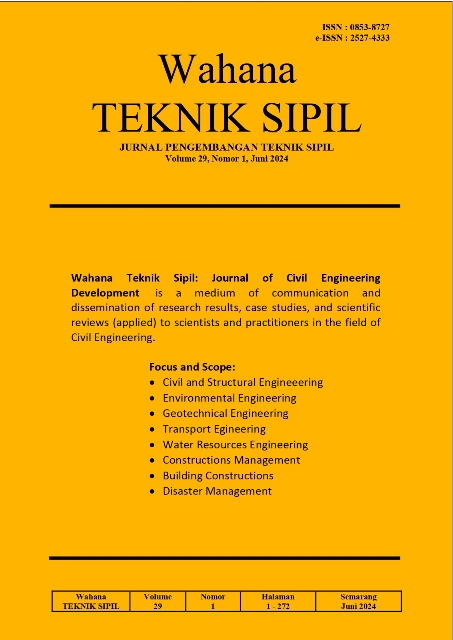ANALISIS DAMPAK KONSENSI TERHADAP KELAYAKAN PROYEK PERKERETAAPIAN
DOI:
https://doi.org/10.32497/wahanats.v29i1.5645Keywords:
High Speed Rail, Concessions, Project Feasibility, Railways, Project ManagementAbstract
Concession agreements have been implemented in many transportation infrastructure projects in Indonesia as a creative step by the government to meet the funding needs of transportation infrastructure projects in the country. The Jakarta-Bandung High-Speed Railway (JBHSR) is a major railway project with substantial investment. Despite securing a 50-year concession, the project has seen escalating investment costs. Nevertheless, the concession significantly impacts the feasibility of the project investment. This study examines and analyzes several factors that influence or are considered in the concession period agreement of railway projects. The research employs a qualitative descriptive method involving literature review, policy document analysis, and expert interviews. The research shows that high-speed railway projects typically have a lengthy return on investment. This is supported by the scarcity of countries globally where such projects have achieved both investment recovery and profitability. Regarding the 50-year concession for the JBHSR Project, it becomes inconsequential when construction issues arise, impacting costs and investment scale. Therefore, a review and reevaluation of the concession period is necessary. Furthermore, certain considerations need to be taken into account when determining the new concession period. The research aims to guide the government in enhancing concession policies, especially concerning railway project concession periods.
References
ADB, 2014, A Comparative Infrastructure Development Assessment of the Republic Korea and The Kingdom of Thailand. Mandaluyong City, Manila, Philippines: Asian Development Bank.
Algaisa, Q., 2023, Analisis Yuridis Masalah Dalam Perjanjian Konsesi Kereta Cepat Jakarta Bandung (KCJB) Antara Indonesia - Cina.
Baskoro, S.I., & Firmansyah, A., 2020, Akuntansi Hak Konsesi sebagai Aset Tak Berwujud pada Perusahaan Penyedia Jasa Jalan Tol di Indonesia. Studi Akuntansi & Keuangan Indonesia, 3(2), 235 - 238.
Bharule, S., Kidokoro, T., & Seta, F., 2019, Evolution of High-Speed Rail and Its Development Effects: Stylized Facts and Review of Relationships. ADBI Working Paper Series, p. 14.
Briginshaw, D., 2014, Shinkansen: half a century of speed.
Claassen, R., 2022, Political Theories of the Business Corporation. Philosophy Compas, 18(1), 1-8.
Crozet, Y., 2013, High Speed Rail Performance in France: From Appraisal Methodologies to Ex-post Evaluation. International Transport Forum, 1-37.
Dehornoy, J., 2018, PPPS in the Rail Sector - A Review of 27 Projects. Open Edition(99-131), 99-131.
Jayani, D.H., 2019, Periode Kedua Pemerintahan Jokowi Butuh US$ 412 M untuk Infrastruktur.
JR-Central, 2023, About the Shinkansen.
Kementerian Keuangan (Kemenkeu), K.P., 2019, Pemerintah Alokasikan Rp 415 Triliun Untuk Pembangunan Infrastruktur.
Komite Percepatan Penyediaan Infrastruktur Prioritas (KPPIP), 2., 2017, Berapa Nilai Proyek Kereta Cepat? Nilai Proyek Transportasi Pemerintah.
Lawrence, M., Bullock, R., & Liu, Z., 2019, China's High-Speed Rail Development (Vol. International Development in Focus). Washington DC, United States of America: International Bank for Reconstruction and Development / The World Bank.
Mulyaman, D., 2020, Comparative Analysis of Indonesia-China High-Speed Train and KTX Korea-France: A Sustainable Development for Locals or Reconfiguring Other Interests. International Journal of Business, Education, Humanities and Social Sciences, 2(2), 1-6.
Ono, A., 1997, Role and Function of Railway Development Fund. Japan Railway & Transport, 14-17.
Perhubungan, K., 2016, Laporan Tahunan Kementerian Perhubungan 2016. Jakarta: Kementerian Perhubungan Republik Indonesia.
Purba, A., 2018, Kereta Cepat: Evolusi Dan Perkembangan Terkini (ISBN: 978-602-262-851-4 ed.). Yogyakarta, Indonesia: Graha Ilmu.
Republik Indonesia, 2021, Peraturan Menteri Perhubungan No PM 38 Tahun 2021 tentang Pengadaan Badan Usaha Dalam Penyelenggaraan Prasarana Perkeretaapian Umum. Jakarta, Indonesia: Kementerian Perhubungan Republik Indonesia.
Republik Indonesia, 2021, Peraturan Menteri Perhubungan Nomor 48 Tahun 2021 Tentang Konsesi dan Kerjasama Bentuk Lainnya Antara Penyelenggara Pelabuhan dengan Badan Usaha Pelabuhan di Bidang Kepelabuhan. Jakarta, Indonesia: Kementerian Perhubungan.
Republik Indonesia, 2021, Peraturan Menteri Perhubungan Nomor PM 81 Tahun 2021 Tentang Kegiatan Pengusahaan di Bandar Udara. Jakarta, Indonesia: Kementerian Perhubungan.
Salim, I.P., Simanjuntak, M.R., & Sulistio, H., 2023, Analisis Kebijakan Pemerintah Dalam Pengembangan Kereta Cepat di Indonesia dan Dampaknya Terhadap Manajemen Proyek. Wahana Teknik Sipil: Jurnal Pengembangan Teknik Sipil, 28, 115-130.
Statista, 2023, Number of high-speed railways in China as of August in 2019, by profit status and speed. Statista Research Department.
Statista, 2023, Total Volume of Passenger Transported by Highspeed Railways in China From 2008 To 2021.
Sugiyono, 2014, Memahami Penelitian Kualitatif. Bandung: Alfabeta.
Downloads
Published
Issue
Section
License
Authors who publish with this journal agree to the following terms:Authors retain copyright and grant the journal right of first publication with the work simultaneously licensed under a Creative Commons Attribution License that allows others to share the work with an acknowledgement of the work's authorship and initial publication in this journal.
Authors are able to enter into separate, additional contractual arrangements for the non-exclusive distribution of the journal's published version of the work (e.g., post it to an institutional repository or publish it in a book), with an acknowledgement of its initial publication in this journal.
Authors are permitted and encouraged to post their work online (e.g., in institutional repositories or on their website) prior to and during the submission process, as it can lead to productive exchanges, as well as earlier and greater citation of published work (See The Effect of Open Access).






